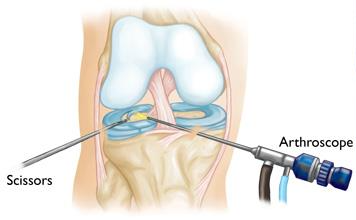Knee
Knee Arthroscopy
Knee arthroscopy is a minimally invasive surgical technique that allows orthopaedic surgeons to diagnose and treat knee problems through small incisions. This procedure involves inserting a small arthroscope (a telescope with a camera) into the knee joint, providing a clear, magnified view of the structures inside the knee. Knee arthroscopy offers numerous advantages, including faster recovery, minimal scarring, and reduced risk of complications compared to traditional open surgery.
What is Knee Arthroscopy?
Knee arthroscopy is a form of keyhole surgery that allows for the diagnosis and treatment of a variety of knee conditions. The procedure uses a small camera, called an arthroscope, to view the inside of the knee joint. It provides real-time images of the knee structures on a monitor, helping the surgeon assess and treat conditions such as:
- Torn Meniscus: The meniscus is a piece of cartilage that cushions the knee joint. Damage to the meniscus is a common cause of knee pain, and arthroscopy can help repair or remove damaged tissue.
- Ligament Tears: The anterior cruciate ligament (ACL) and other knee ligaments are frequently injured in sports. Arthroscopy allows for precise repairs of these ligaments.
- Patella Issues: Knee arthroscopy can treat problems related to the kneecap, such as misalignment or cartilage damage.
- Loose Bone or Cartilage Fragments: Arthroscopy can remove fragments that may cause pain or limit movement.
- Knee Sepsis (Infection): In cases of infection within the knee joint, arthroscopy helps in cleaning and treating the affected area.

Procedure: What to Expect
The arthroscopy procedure is typically performed as a day-case surgery, meaning that patients can usually go home on the same day. The procedure begins with small incisions around the knee, through which the arthroscope is inserted. The camera transmits images to a monitor, allowing Dr. Ryan du Sart to examine the joint in great detail. If treatment is needed, additional small instruments are used to perform necessary repairs or remove damaged tissue.
This procedure typically takes between 15 to 30 minutes, depending on the complexity of the issue being treated. The small incisions ensure minimal scarring, and the procedure offers fast recovery times compared to traditional open surgery.
Post-Operative Care: Pain Management and Mobility
Pain management after knee arthroscopy is usually straightforward. Patients are typically prescribed paracetamol and anti-inflammatory medications to control pain and swelling. Stronger pain relief may be prescribed initially but is gradually phased out as recovery progresses. Ice therapy and elevation of the knee are also recommended to minimise swelling.
One of the most significant advantages of knee arthroscopy is the quick recovery time. Most patients can resume weight-bearing activity shortly after surgery, and crutches are typically not required. While specific physiotherapy is usually not necessary, performing simple range-of-motion exercises (such as bending and straightening the knee) is encouraged to restore mobility and strengthen the knee.
Return to Work and Sports
Your return to work and sport will depend on the nature of your surgery and the type of work you do. For most patients, a 1-2 week recovery period is sufficient to allow the knee to heal and reduce swelling. Low-impact activities like swimming, cycling, and hydrotherapy can typically be resumed within 4 weeks of surgery to help restore muscle strength and flexibility. However, high-impact activities, such as running and jumping, should be avoided for at least 12 weeks post-operation. Dr. du Sart and your physiotherapist will guide you on specific exercises and activity restrictions based on your individual recovery.
Driving After Knee Arthroscopy
The timing for returning to driving varies depending on the nature of your surgery. For patients who have had left knee surgery and drive an automatic car, the ability to drive may return in as little as 3 to 4 days after the procedure. However, it's essential to wait until you have regained full motion and control of the knee before driving. If you have concerns about when it is safe to return to driving, Dr. du Sart will provide personalised advice based on your recovery progress.
Why Choose Dr. Ryan du Sart for Knee Arthroscopy?
Dr. Ryan du Sart is an experienced orthopaedic surgeon with a focus on minimally invasive surgical techniques, including knee arthroscopy. He offers a patient-centred approach, tailoring treatment plans to the individual needs and goals of each patient. Dr. du Sart utilises the latest technology and techniques to ensure the best possible outcomes and a faster recovery for his patients.
Book a Consultation
If you're experiencing knee pain, stiffness, or difficulty with movement, knee arthroscopy may offer a solution. Early intervention can prevent further damage and lead to a faster, more effective recovery. Schedule a consultation with Dr. Ryan du Sart today to explore your treatment options.
Phone: (08) 9779 9767
Email:
admin@ryandusart.com.au
Clinic Locations:
6 Higgins Street, South Bunbury, WA 6230
20 Prince Street, Busselton, WA 6280
References:
- Robinson, J. R., et al. (2018). "Arthroscopic Surgery in the Treatment of Knee Disorders: A Review of Clinical Outcomes." Journal of Orthopaedic Surgery and Research.
- Baker, M. G., et al. (2017). "Outcomes of Knee Arthroscopy for Meniscal Tears: A Review of the Literature." Bone and Joint Journal.
- Australian Orthopaedic Association (AOA). "National Joint Replacement Registry." Annual Report, 2022.
- Webb, P., et al. (2019). "Minimally Invasive Knee Arthroscopy and Its Impact on Recovery and Function." The Journal of Knee Surgery.

